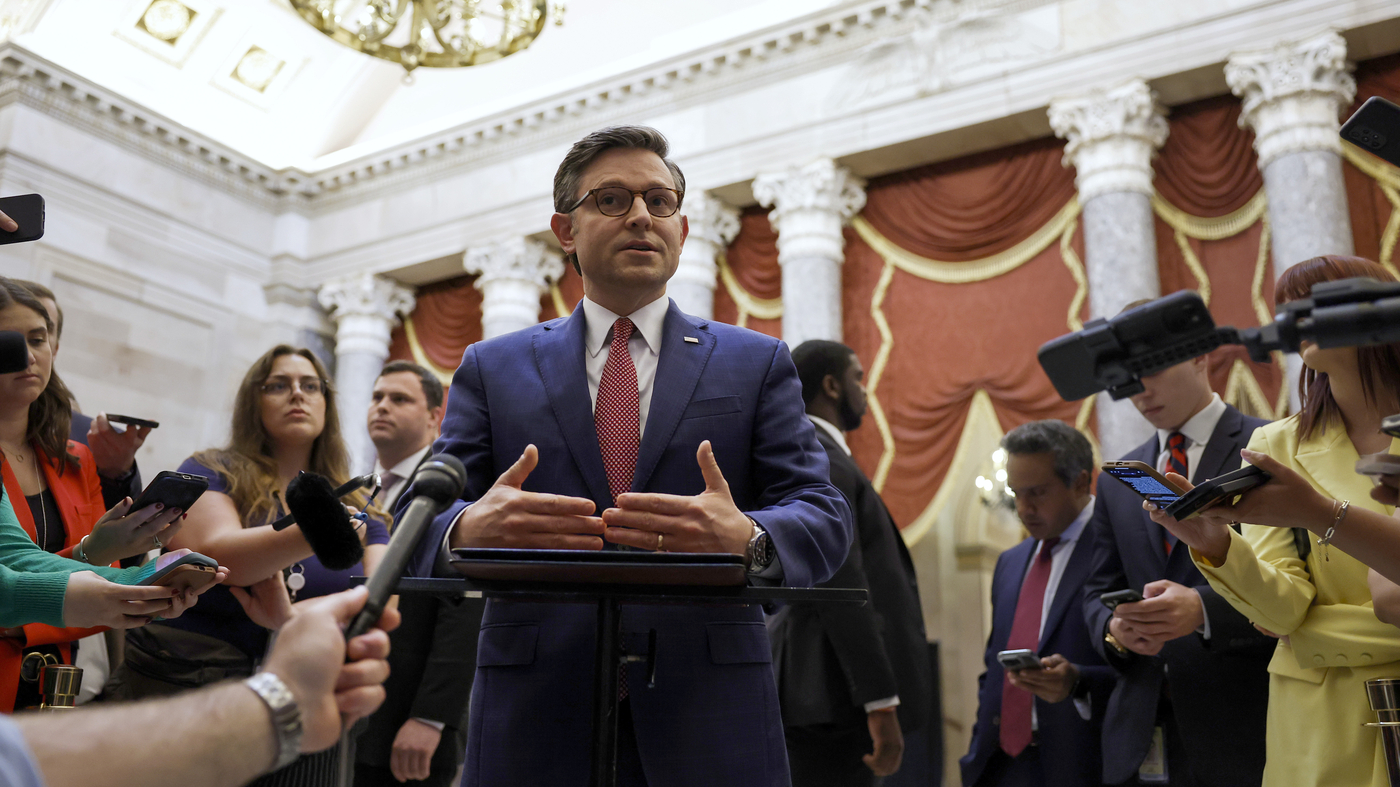
[ad_1]

Speaker of the House Mike Johnson speaks with reporters in Statuary Hall after meeting with Reps. Marjorie Taylor Greene and Thomas Massie on May 6.
Anna Moneymaker/Getty Images
hide caption
toggle caption
Anna Moneymaker/Getty Images

Speaker of the House Mike Johnson speaks with reporters in Statuary Hall after meeting with Reps. Marjorie Taylor Greene and Thomas Massie on May 6.
Anna Moneymaker/Getty Images
The House voted overwhelmingly to set aside a motion by Rep. Marjorie Taylor Greene to call a vote to remove Mike Johnson as speaker of the House. The vote was 359-43 with seven members voting present. 196 Republicans and 163 Democrats voted to table the motion.
“Hopefully, this is the end of the personality politics and the frivolous character assassination that has defined the 118th Congress,” Johnson told reporters after the vote. “It’s regrettable. It’s not who we are as Americans and we’re better than this — we need to get beyond it.”
As promised, House Democrats largely supported Johnson in setting aside the call for his removal, making Greene’s endeavor symbolic. Only 10 Republicans voted alongside Greene.

The vote was the culmination of weeks of threats from the Georgia Republican.
While the measure failed, Greene and other Republicans remain angry with Johnson’s reliance on votes from Democrats to pass major legislation.
“Mike Johnson worked with [Senate Majority Leader] Chuck Schumer rather than the conference and gave Joe Biden and the Democrats everything they wanted — no different from how a Speaker Hakeem Jeffries would have done,” Greene said on the floor, reading a litany of criticisms against Johnson.
“This is the uni-party for the American people watching,” Greene said as the House chamber erupted into boos as she brought forward the motion to vacate.

Rep. Marjorie Taylor Greene and Rep. Thomas Massie are seen here arriving for a meeting with Speaker of the House Mike Johnson on May 7.
Kent Nishimura/Getty Images
hide caption
toggle caption
Kent Nishimura/Getty Images

Rep. Marjorie Taylor Greene and Rep. Thomas Massie are seen here arriving for a meeting with Speaker of the House Mike Johnson on May 7.
Kent Nishimura/Getty Images
How Greene got here
Greene has been weighing whether to trigger a vote to oust Johnson since she filed the motion in March, after objecting to his negotiating with Democrats on a $1.2 trillion spending package that ultimately passed the House with more Democratic support than Republican support.
Last week, Greene threatened to move forward with the motion to vacate after the House voted on an aid bill for Ukraine.
Two Republican co-sponsored her resolution — Arizona Rep. Paul Gosar and Kentucky Rep. Thomas Massie.
Greene met twice this week with Johnson, including an over two-hour meeting on Monday.
“Everybody was listening — it wasn’t a shouting match,” Massie said of the Monday meeting. “[Greene] and I decided to give Speaker Johnson one last chance to say he’s going to be with the Republicans and not with the Democrats, and there are some litmus tests on that.”
Greene and Massie said those litmus tests include no additional funding for Ukraine, no funding toward the special counsel investigation into former President Donald Trump, and Johnson only bringing legislation to the floor that has the support of the majority of the GOP conference.

In an appearance on Steve Bannon’s “War Room” podcast Tuesday, Greene said she also wants twelve separate appropriations bills and not another omnibus led by Schumer “rammed down our throat.”
“That will not be tolerated again,” she said, adding that if House Republicans don’t get the twelve distinct bills, she wants to see a one percent cut to spending.
Although members of the hardline House Freedom Caucus have expressed dissatisfaction with Johnson’s actions in his short tenure as speaker, most say they still don’t want to put the conference through another speaker fight.
Greene has also been under pressure from former President Trump. Greene and Trump spoke over the weekend and Trump urged her to back down, according to a source familiar with the conversation.
After the vote on Wednesday, Trump took to social media to request that Republican members vote to table the motion.
“We’re not in a position of voting on a Motion to Vacate,” he wrote. “At some point, we may very well be, but this is not the time.”
[ad_2]